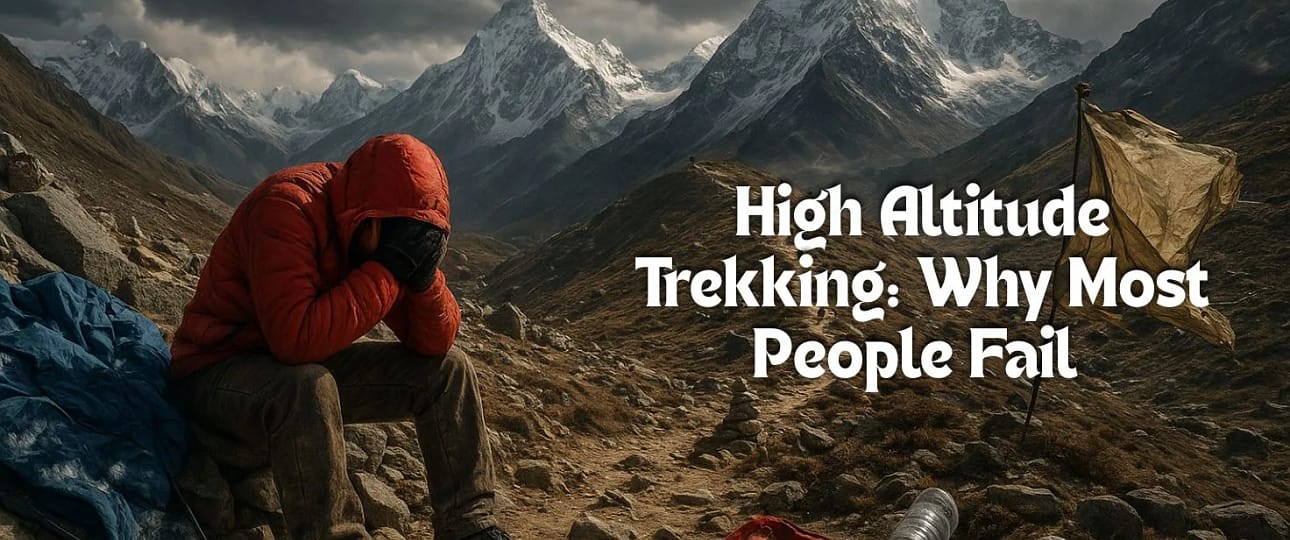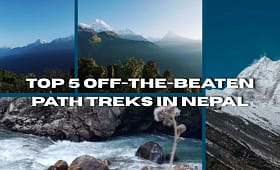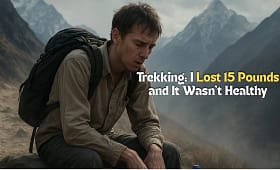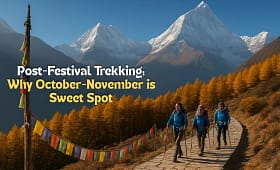So here’s the brutal truth about high altitude trekking most people absolutely suck at it. Not because they’re weak or stupid, but because they show up to the Himalayas with zero clue about what they’re actually getting into. You see it everywhere: Everest Base Camp trek turned into a rescue mission, Annapurna Circuit dreams becoming altitude nightmares, perfectly capable people getting their asses handed to them by mountains that don’t care about their gym membership.
The thing is, high altitude mountaineering isn’t just regular hiking with better views. It’s a completely different game where your body does weird shit, your brain stops working properly, and suddenly that 6000m peak you thought would be “challenging but doable” becomes a life-or-death situation. But here’s the kicker – most of these failures are totally preventable if people just did their homework.
Let’s talk about why people crash and burn in the thin air, and more importantly, how to not be one of those cautionary tales that mountain rescue teams love to complain about.
The “I’m In Shape” Delusion
Here’s the first place people screw up massively: thinking that because they can run a marathon or crush it at CrossFit, they’re ready for Himalayan trekking. Wrong. Dead wrong. High altitude fitness is a completely different beast than sea-level cardio, and your ability to bench press your bodyweight means exactly nothing at 5000 meters.
Altitude acclimatization doesn’t care about your VO2 max or how many burpees you can do. I’ve seen ultra-marathoners get destroyed by altitude sickness on Island Peak climbing attempts, while out-of-shape but smart trekkers cruise past them because they understood the game they were playing.
The problem is oxygen saturation. At Everest Base Camp elevation, you’re getting about 50% of the oxygen you’re used to. Your cardiovascular system, no matter how well-trained, has to adapt to completely different conditions. Aerobic capacity plummets, heart rate goes crazy, and suddenly you’re gasping like a fish on day three of what should be an easy tea house trek.
Ignoring the Sacred Rule of Acclimatization
“Climb high, sleep low” isn’t just some cute mountaineering saying it’s literally the difference between success and helicopter evacuation. But people ignore this acclimatization strategy constantly because they’re impatient, overconfident, or just don’t understand how altitude physiology actually works.
Rapid ascent kills dreams faster than anything else in high altitude environments. You’ll see people booking direct flights to Lukla and then trying to blast straight up to Namche Bazaar and beyond without proper rest days. Your body needs time to produce more red blood cells, adjust blood pH, and basically reprogram itself to function with less oxygen.
The golden rule is simple: above 3000 meters, don’t gain more than 500 meters of sleeping elevation per day. Take acclimatization days every 1000 meters of gain. It’s not optional, it’s not for weak people, it’s basic mountain physiology. Ignore it and you’ll be that person getting carried down the mountain by yaks while other trekkers shake their heads.
Gear Disasters That Turn Dreams Into Nightmares
Trekking gear failures in the high Himalayas aren’t just inconvenient – they can be deadly. And most gear disasters happen because people either cheap out on critical equipment or show up with completely inappropriate stuff they bought online without understanding mountain conditions.
Sleeping bags rated for the wrong temperatures turn mountain lodges into misery chambers. You think you’re saving money with that “suitable for 0°C” bag, but at 4000 meters in Langtang during winter trekking, you’re going to spend every night shivering and getting zero recovery sleep. Down insulation stops working when wet, synthetic fills are heavier but more reliable – most people have no idea which they actually need.
Trekking boots are where people really screw themselves. Showing up to Annapurna Base Camp trek with brand new boots that haven’t been broken in? You’re going to have blisters that make walking impossible by day two. Altitude plus foot problems equals early exit from your Himalayan adventure.
The Mental Game Nobody Talks About
High altitude psychology is real, and it destroys people who are only prepared physically. Thin air affects your brain before it affects your muscles. Decision-making gets impaired, patience disappears, and suddenly you’re making choices that would seem obviously stupid at sea level.
Acute mountain sickness isn’t just nausea and headaches – it’s cognitive impairment. People become irritable, confused, and unable to assess their own condition accurately. I’ve seen perfectly rational adventure travelers insist they’re fine while exhibiting obvious signs of high altitude cerebral edema. Your brain literally swells inside your skull, and you lose the ability to recognize that you’re in serious trouble.
Mental preparation for long-distance trekking means accepting that you’re going to feel like garbage sometimes. You’ll question your decisions, hate the mountain weather, and wonder why you paid good money to suffer. That’s normal. The problem comes when people panic at the first sign of discomfort and make bad decisions about descent vs evacuation.
Choosing the Wrong Trek for Your Experience Level
This is where ego destroys trekking dreams faster than altitude sickness. People see those Instagram photos from Everest Base Camp or Annapurna Circuit and think “how hard could it be?” without understanding that these aren’t beginner hiking trails they’re serious high altitude expeditions that require specific skills and experience.
Everest Base Camp trek is not a good first high altitude experience. Thorong La Pass on the Annapurna Circuit is not where you want to learn about altitude management. Manaslu Circuit trek is definitely not the place to figure out if you can handle remote trekking conditions.
Smart progression looks like Poon Hill trek first, then maybe Annapurna Base Camp trekking, then Langtang Valley trek, building experience with altitude exposure, tea house accommodation, and Himalayan weather before attempting the big-name routes. But people want the bragging rights without paying the learning dues.
Underestimating Weather and Seasonal Conditions
Mountain weather in the Himalayas is not your local hiking trail forecast. Weather patterns can change in minutes, temperature swings are extreme, and seasonal variations make the difference between epic adventure and survival situation.
Monsoon season in Nepal isn’t just “a bit rainy” – it’s landslides, trail washouts, leech-infested forests, and visibility so bad you can’t navigate mountain passes. But people book June-August treks because it’s convenient for their vacation schedule, not because it makes sense for Himalayan conditions.
Winter trekking brings extreme cold, frozen water sources, closed tea houses, and avalanche risk that most people aren’t prepared for. Spring weather can mean unstable snow conditions on high passes. Autumn storms can dump snow unexpectedly and trap people in mountain valleys.
Poor Guide Selection and Independence Delusions
Solo trekking in the Himalayas sounds romantic until you’re lost in a whiteout at 4500 meters with no idea which direction leads back to civilization. Independent trekking requires serious navigation skills, emergency preparedness, and risk assessment abilities that most people simply don’t have.
But trekking guide selection is where people often screw up just as badly. Cheap guides without proper mountaineering training or first aid certification are worse than useless – they’re dangerous. Unlicensed operators cut corners on safety, emergency equipment, and rescue protocols.
Professional trekking guides with high altitude experience and wilderness first aid training cost more money, but they’re the difference between adventure and disaster. Porter treatment, fair wages, and proper equipment for your support crew aren’t just ethical issues they affect your safety when things go wrong.
Nutrition and Hydration Failures at Altitude
High altitude nutrition gets ignored by people who think they can just eat whatever’s available at mountain tea houses and hope for the best. Appetite loss is normal above 3500 meters, but you still need calories to fuel your body through challenging trekking days.
Dehydration happens faster at altitude because you lose more water through increased respiration. Dry air and increased urination compound the problem. People think they’re being smart by rationing water to avoid bathroom breaks, but dehydration makes altitude sickness worse and recovery slower.
Carbohydrate loading becomes critical for high altitude performance. Protein synthesis is impaired in thin air, so your usual high-protein diet might not work. Electrolyte balance gets screwed up by altitude diuresis. Most people have no idea how to eat for mountain conditions.
Altitude Sickness: When Your Body Rebels
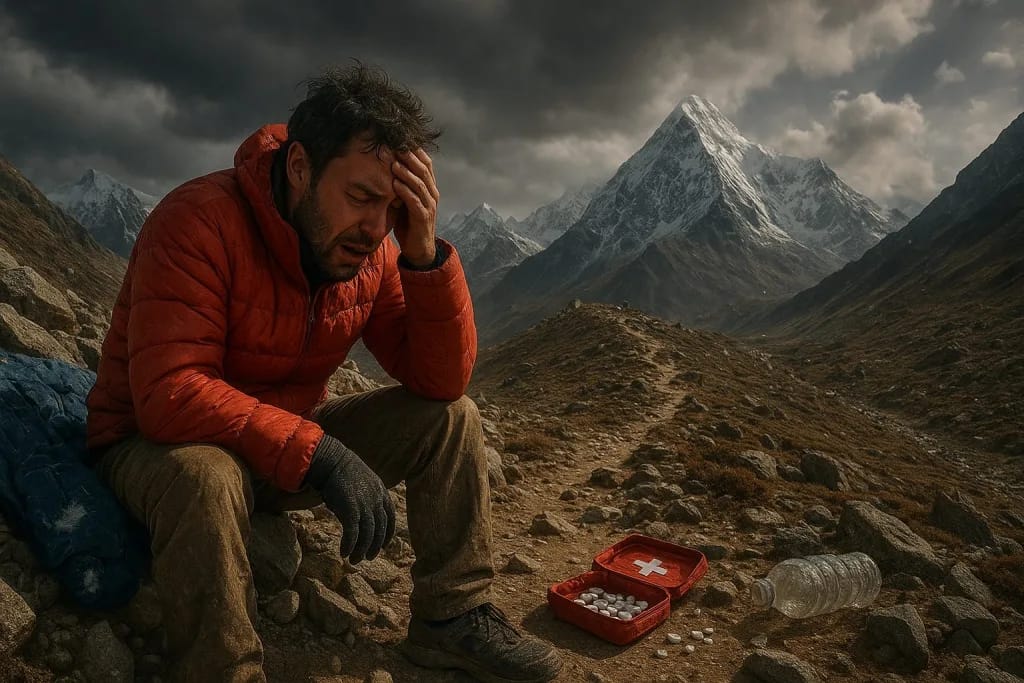
Acute Mountain Sickness (AMS) is not just feeling a bit tired and headachy – it’s your body telling you that you’re in an environment it’s not designed for. Mild AMS is manageable with proper acclimatization, but High Altitude Pulmonary Edema (HAPE) and High Altitude Cerebral Edema (HACE) will kill you if you ignore the signs.
AMS symptoms – headache, nausea, fatigue, dizziness – these aren’t just inconveniences to push through. They’re early warning systems that your acclimatization isn’t keeping up with your ascent rate. Prevention is everything because treatment at high altitude is limited to descent and evacuation.
Diamox (acetazolamide) helps with acclimatization, but it’s not a magic pill that lets you ignore proper ascent rates. Dexamethasone can buy you time in emergency situations, but it masks symptoms without treating the underlying problem. Portable altitude chambers exist, but they’re last-resort tools, not prevention strategies.
Technology Failures and Communication Breakdowns
GPS devices fail in mountain weather. Smartphones die in cold temperatures. Satellite communicators have dead zones in deep valleys. People show up to serious high altitude treks assuming their technology will save them, without backup navigation skills or emergency protocols.
Weather forecasting in the Himalayas is notoriously unreliable. Satellite internet in mountain tea houses is spotty at best. Cell phone coverage disappears above certain elevations. Emergency communication becomes impossible when you need it most.
Solar chargers don’t work in cloudy conditions. Power banks lose capacity in extreme cold. Electronic altimeters can malfunction. The mountains don’t care about your fancy gadgets when you’re truly in trouble.
The Economics of Cutting Corners
Budget trekking in Nepal often means cutting safety corners that turn manageable risks into serious dangers. Cheap trekking packages skip acclimatization days, use inexperienced guides, and scrimp on emergency equipment. You think you’re saving money until you need a helicopter evacuation that costs more than your entire annual salary.
Quality gear costs money upfront but prevents expensive rescue operations later. Professional guides and reputable trekking companies charge more because they invest in safety training, proper equipment, and emergency preparedness. Insurance coverage for adventure activities is expensive but essential.
Porter welfare and fair wages aren’t just ethical issues – well-treated support staff are more motivated to help when things go wrong. Exploitative trekking practices create safety risks that affect everyone on the mountain.
Rescue Reality: When Adventure Becomes Emergency
Helicopter rescue in the Himalayas isn’t like calling 911. Weather conditions can ground rescue helicopters for days. Altitude limitations mean some locations are beyond helicopter reach. Rescue costs can exceed $10,000 USD, and insurance companies look for reasons not to pay.
Ground evacuations by yak or stretcher take days and depend on porter availability. Medical facilities in mountain regions are basic at best. Serious altitude-related illnesses require immediate descent and evacuation to Kathmandu or beyond.
Emergency preparedness means having evacuation insurance, emergency contacts, satellite communication, and most importantly, the judgment to retreat before rescue becomes necessary. Mountain emergencies test everything – your preparation, your gear, your decision-making, and your luck.
Learning From Others’ Epic Failures
Trekking forums and mountaineering communities are full of failure stories that repeat the same mistakes over and over. People attempt high altitude treks without adequate cardiovascular training. Inexperienced trekkers ignore weather warnings. Overconfident climbers push past obvious turnaround points.
Social media creates pressure to complete treks for the photos rather than making smart safety decisions. Summit fever affects trekkers just like mountaineers – the inability to turn back when conditions deteriorate. Group dynamics can pressure individuals to continue when they should descend.
Post-trip analysis of what went wrong is how you learn from close calls without having to experience them yourself. Debriefing with experienced guides after challenging treks helps identify decision points where things could have gone differently.
The Altitude Training Nobody Does
Pre-acclimatization training at high altitude isn’t just for professional mountaineers – it’s smart preparation for anyone planning serious Himalayan adventures. Altitude training masks and hypoxic chambers can help prepare your body for reduced oxygen environments.
VO2 max testing and lactate threshold analysis can identify your aerobic capacity limitations before you discover them at 5000 meters. Cardiorespiratory fitness specific to altitude conditions requires different training than sea-level endurance sports.
Sleep studies can identify sleep apnea or other respiratory issues that become dangerous at high altitude. Cardiovascular screening can catch underlying conditions that altitude exposure might trigger. Medical clearance for high altitude activities isn’t just liability protection – it’s smart risk management.
Weather Window Management and Timing
Seasonal planning for high altitude treks requires understanding monsoon patterns, winter storms, and spring conditions. Weather windows for high passes and exposed ridges can be measured in hours, not days. Flexible itineraries that can adapt to changing conditions prevent forced marches in dangerous weather.
Barometric pressure changes signal approaching storms long before visual weather signs. Wind speed and wind direction affect perceived temperature and chill factors dramatically. Cloud formations around high peaks indicate developing weather systems.
Evacuation weather minimums for helicopter operations mean that rescue flights aren’t possible in many mountain weather conditions. Ground evacuation becomes the only option, requiring multiple days and favorable conditions.
The Psychology of Turning Back
Summit fever affects trekkers just like technical climbers – the inability to make rational turnaround decisions when objective conditions deteriorate. Investment bias makes people push forward because they’ve already spent money and time getting to high altitude.
Group pressure and social media expectations create psychological pressure to complete treks even when safety margins are compromised. Guide dependency can prevent independent decision-making about personal limits and risk tolerance.
Ego management is a critical high altitude skill. Recognizing when you’re out of your depth and making smart retreat decisions requires more courage than pushing forward into dangerous conditions. Living to trek another day is better than becoming a cautionary tale.
The Bottom Line: Respect the Mountains or Get Humbled
High altitude trekking in the Himalayas will expose every weakness in your preparation, judgment, and risk management. The mountains don’t care about your social media followers, your vacation schedule, or your ego. They’ll humble you faster than you can say “Everest Base Camp” if you show up unprepared.
Successful high altitude adventures require physical preparation, mental toughness, quality equipment, experienced guidance, and most importantly, smart decision-making when conditions change. Failure usually comes from cutting corners on preparation, ignoring safety protocols, or pushing beyond personal limits when the smart move is retreat.
The difference between epic adventure and expensive rescue often comes down to small decisions made before you ever set foot on the mountain. Respect the altitude, prepare properly, choose experienced partners, and always have an exit strategy. The Himalayas will still be there next year if you need to turn back and try again with better preparation.
Mountain humility isn’t weakness – it’s survival intelligence. The people who succeed at high altitude trekking aren’t necessarily the strongest or most experienced. They’re the ones who understand the risks, prepare appropriately, and make smart decisions when the mountains test them. Don’t be another failure statistic – be the person who comes home with amazing stories and all their fingers and toes intact.

